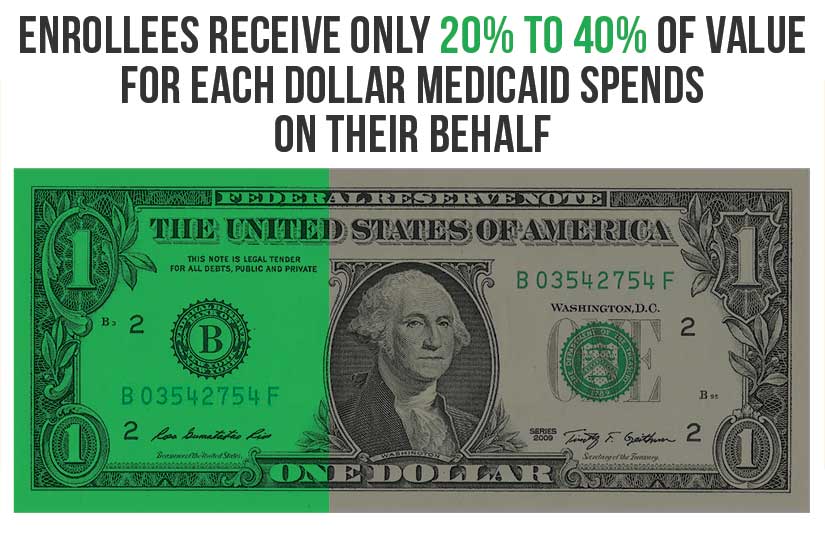Medicaid Needs to Be Improved, Not Expanded
-
The White House will propose in the president’s budget to provide states that have not yet expanded their Medicaid programs with another opportunity for three years of 100 percent federal funding.
-
Beneficiaries only get 20 to 40 cents of value for every Medicaid dollar spent.
-
Medicaid needs to be reformed, not expanded – low-income Americans should not be relegated to second-class health care.
White House wants to expand Medicaid expansion
The Obama administration is planning to include in the president’s budget a proposal to allow a further expansion of the Medicaid program. The proposal would give states that have not yet expanded their programs an additional opportunity for three years of 100 percent federal funding for newly eligible beneficiaries.
Obamacare allowed states to expand Medicaid eligibility to people with income up to 138 percent of the federal poverty level. Thirty-one states and the District of Columbia have expanded Medicaid. Under the health law, the federal government pays 100 percent of the costs for these newly eligible people for 2014, 2015, and 2016. Federal funding is scaled back to 95 percent in 2017; and to 90 percent in 2020 and after.

Medicaid has grown beyond its original purpose
Medicaid is a vital part of America’s safety net. It was designed to ensure that the most vulnerable Americans would have access to health care. For 50 years, it has provided some measure of care to low-income parents, children, seniors, and disabled Americans. As the program has aged; however, the population it serves has grown, and the care the program is able to provide has dwindled. It has become difficult for Medicaid to achieve its primary purpose. In its first year, Medicaid served just 4 million people. Last year, the program covered an average of 76 million people each month – more than one in four Americans – and CBO projects the number will rise to 77 million this year. As a result, a Medicaid card often does not mean medical care.
Last week, CBO released its Budget and Economic Outlook for 2016-2026 and significantly adjusted its projections for Medicaid. CBO boosted its enrollment projections for 2025 by 3 million people. It also increased its spending projections over 10 years by $187 billion. CBO attributes the increases to Obamacare’s Medicaid expansion.
Medicaid expansion makes up most of the decrease in the number of people without insurance that the Obama administration has touted. In 2014 for example, 9.25 million people gained coverage; however, most of this increase was due to 8.99 million people being added to the Medicaid rolls. Given the inability of Medicaid to meet its existing commitments before Obamacare, this crowding of the program risks the care low-income seniors, children, parents of young children, and disabled Americans receive.
Medicaid needs to be improved
Medicaid needed reform before Obamacare expanded it. A June 2015 study by researchers at Harvard, MIT, and Dartmouth found that Medicaid enrollees only get 20 to 40 cents of benefit for each dollar spent on the program. Other research has found that Medicaid enrollees tend to suffer worse outcomes than similar patients without Medicaid. Low provider payment rates in many states result in Medicaid recipients having a difficult time finding doctors. An analysis in Health Affairs in 2013 found that, even before Medicaid expansion, only 67 percent of primary care physicians accepted Medicaid patients.
As the program expands further, the problem will get worse. An increasing share of taxpayer dollars will be spent on able-bodied, working-age adults rather than the people who Medicaid was created to help. Medicaid patients will have a more difficult time finding doctors and getting appointments, and they will increasingly experience worse health outcomes.
It is important to remember Medicaid’s mission: to protect the most vulnerable among us and to ensure that those who cannot work or afford health insurance still have access to care. The path followed by the Obama administration and Washington Democrats leads to everyone having coverage, but only those who can afford it having care. Low-income mothers, children, the elderly, and disabled Americans deserve better than to be relegated to second-tier health care.
Alternative models would better serve patients
Republicans have detailed options for improving Medicaid. The alternatives would give states the tools to create patient-centered reform and instill fiscal discipline in the program. Advocates of expanding our obsolete Medicaid program either fail to realize or fail to care that the current system leaves low-income Americans with low-level care. States should have the flexibility to design Medicaid programs that will best serve the low-income people in their states.
Per capita cap model: This model provides a fixed amount of funding for each enrolled beneficiary. Amounts could vary based on eligibility categories and geographic location. While the federal government would still oversee the program, states would be encouraged to provide high-quality care through innovation.
State flexibility funds or block grants: This model provides fixed allotments to states to provide care to their eligible beneficiaries. States are freed from many of Washington’s burdensome regulations and encouraged to provide high-quality care through innovation.
Long-term services and supports: States are working to improve their long-term services and supports programs to encourage elderly and disabled people to seek care in the setting that best fits their needs. These long-term needs are expected to rise with an aging population, so developing sound policies is a Republican priority. Programs like the “Money Follows the Person” demonstration offer an opportunity to ensure responsible use of taxpayer dollars.
Work requirements for able-bodied adults: Including work requirements for able-bodied adults serves the vision of Medicaid by providing government assistance when people fall on hard times, while encouraging them to work to improve their situation. Reasonable work requirements help to lift families out of poverty and into the middle class.
Next Article Previous Article
